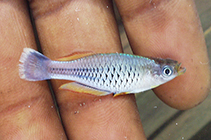| Diagnosis: |
Dorsal spines (total): 0-0; Dorsal soft rays (total): 12-14; Anal spines: 0-0; Anal soft rays: 18-21; Vertebrae: 30-30. Diagnosis: This species is distinguished from all other Hylopanchax species except for Hylopanchax leki by the position of the insertion of the dorsal fin (D/A = 8-11 vs. D/A = 11-14), the number of dorsal fin rays (12-14 vs. 6-9), the number of pectoral fin rays (12-13 vs. 8-10), the number of transversal scales (18-22 vs. 15-16), by its deep body (24.3-34.3% of standard length vs. 16.3-25.6% of standard length), by the low caudal peduncle ration (1.2-1.5 vs. 1.6-2.4), and by having 2 or 3 rows of scales underneath the eye versus 1 row of scales; it has longer dorsal spines of vertebrae at mid-body versus short dorsal spines with lower length differences between mid-body and anterior or posterior spines (Ref. 94189). Its is distinguished from Hylopanchax leki by having more scales in the longitudinal line (24-26 vs. 21-23) and male colour pattern; snout and lower jaw yellow versus dark orange snout and lower jaw in H. leki; dorsal and anal fin yellow with red distal edges versus dark orange anal and dorsal fin (Ref. 94189).
Description: A large and deep Hylopanchax species, laterally strongly compressed; dorsal profile convex, slightly concave at nape; greatest body depth between pelvic and anal fin; ventral profile convex from head to end of anal fin; snout rounded, mouth directed upwards, lower jaw longer than upper jaw; on both jaws an outer row of larger, slightly curved conical teeth, inner teeth row more irregular arranged with smaller teeth; symphysis forming a ridge on lower and less on upper jaw; branchiostegal appendages present in adult males (Ref. 94189). Frontal and nasal neuromasts not present, one pre-orbital neuromast in short shallow open groove; post-orbital and supra-orbital neuromast system provided with large neuromasts and large lobes, covering a great part of the groove; pre-opercular neuromast system with 5 pores (Ref. 94189). Scales cycloid, body completely scaled except ventral head surface, 2 or 3 rows of scales underneath the eye, frontal squamation of G-type, no scales on dorsal and anal fin base, scales on mid longitudinal series 24-26 (Ref. 94189). Number of dorsal fin rays 12-14, anal fin rays 18-21, caudal fin rays 24-26, pelvic fin rays 6, pectoral fin rays 12-13; first dorsal fin ray above anal fin ray 8-10 (Ref. 94189).
Colouration: Males have back olive brown, flanks silverish with blue shine, changing to white on ventral side, snout and lower jaw yellow; throat white; flanks with four to five rows of scales anteriorly edged with black crescent shaped markings; dorsal and anal fins yellow with red edge, pelvic fins yellow with red margin; caudal fin blue with posterior white edge; pectoral fins translucent; narrow black band at base of anal fin; urogenital papilla black (Ref. 94189). No information on live colouration is available for females (Ref. 94189). |

